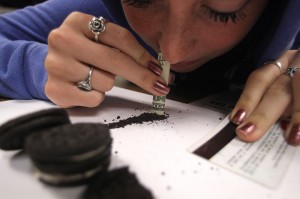
Travis Taylor | Lariat Photo Editor
Reporter
Whether you’re a twister or a dunker, eating just one Oreo may seem next to impossible. A recent study might hold the clue to this phenomenon.
Research conducted by college students and a professor at Connecticut College has found that “Milk’s favorite cookie” is as addictive as drugs, at least to lab rats.
However, the results are only preliminary and merely suggest links between brain activity and diet. The study has yet to be presented or published in a peer-reviewed journal.
The research will be presented next month at the Society for Neuroscience conference in San Diego, Calif.
A press release provided by Connecticut College states that the study was designed to shed some light on the potential high fat/high sugar foods have to be addictive.
Dr. Joseph Schroeder, an associate professor of psychology and the director of the neuroscience program at Connecticut College, was the faculty member who oversaw and guided the study.
“Our research supports the theory that high-fat/high sugar foods stimulate the brain in the same way that drugs do,” Schroeder said in a press release. “It may explain why some people can’t resist these foods despite the fact that they know they are bad for them.”
They found that the Oreos activated significantly more neurons in the brains of rats than cocaine or morphine.
This correlated well with the results of the behavioral tests, Schroeder said.
Addiction is a chemical reaction within the brain.
“Anytime we have a pleasurable experience we engage the pleasure circuit in the brain,” said Dr. Don Arterburn, addictive substance specialist at Baylor. “Dopamine is released from the midbrain to the frontal cortex and glutamate is released down to the midbrain in response. This pleasure feedback system is affected by our genetics, depth of reward, memory of that reward, stress. All of these factors affect craving and the choices we make about how to handle those cravings.”
This explains why some people are drawn to sugar.
“Sugar has a high reward in most people’s brains and therefore can be addictive if a person habitually used foods high in sugar to deal with stress, pain, boredom and other forms of emotional disregulation,” Arterburn said.
The 2010 Dietary Guidelines, jointly issued every five years by the Department of Agriculture and the Department of Health and Human Services, recommend limiting total intake of discretionary calories, which include added sugars and solid fats, to 5 to 15 percent of daily caloric intake, yet many Americans continue to exceed these recommendations, according to research from the Centers for Disease Control and Prevention.
The study was ultimately the brainchild of Connecticut College senior Jamie Hoonahan, who was specifically interested in how the prevalence of high fat/high sugar foods is contributing the obesity epidemic in America.
“Even though we associate significant health hazards in taking drugs like cocaine and morphine, high fat/high sugar foods may present even more of a danger because of their accessibility and affordability,” Honohan said in a press release.
Sugar can in fact be an addiction for some people.
“Signs of a problems would be: an increasing tolerance to sugar where more and more of the substance was needed to achieve the desired effect, withdrawal symptoms if use is discontinued, and continued use despite negative consequences,” Arterburn said. “If a diabetic will not change their diet even though they have had negative health consequences, we might suspect an addiction to sugar.”
The study was conducted with rats in a maze. On one side they would give hungry rats Oreos, and on the other they would give a control group rice cakes. They would allow the rats to go to the other side, and then would measure the amount of time spent on the side where they were fed Oreos. They then compared these results with results from a test where rats were given known addictive substances such as cocaine and on the other given saline. These results were comparable in that the rats spent as much time on the Oreo side as they did on the drug side of the maze.
Lauren Cameron, a junior at Connecticut College, used immunohistochemistry, which is a process that measures proteins that mark normal activation in the brains pleasure center.
Kimberly Fontes, senior manager of North American Communications for Mondelez Global LLC, the manufacturer of Oreos, wrote in an email to the Lariat, “Our understanding is that the actual study has not yet been peer-reviewed nor published, or even presented in abstract form. As we have not seen it, nor had any contact with the professor or school where the research took place, we are not in a position to comment on research specifics and/or methodology.
“We would caution against interpreting any results as specific to Oreo cookies, since they appear to be used in this research as a proxy for a non-specific ‘sweet’ variable.
“While it may seem simple to bucket foods as ‘good’ or ‘bad’, the reality is that foods are complex, and encouraging people to enjoy a balanced diet paired with physical activity is most important.”






